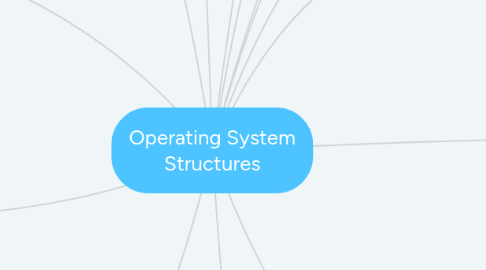
1. Layered Approach
1.1. operating system is divided into a number of layers (levels), each built on top of lower layers. The bottom layer (layer 0), is the hardware; the highest (layer N) is the user interface.
1.2. With modularity, layers are selected such that each uses functions (operations) and services of only lower-level layers.
1.3. Advantage
1.3.1. Simplicity of construction and debugging
1.4. Disadvantages
1.4.1. The careful definition and interaction of the layers
1.4.2. Less efficient
2. Microkernel
2.1. Small operating system core
2.2. Contains only essential core operating systems functions
2.3. Many services traditionally included in the operating system are now external subsystems
2.3.1. Device drivers
2.3.2. File systems
2.3.3. Virtual memory manager
2.3.4. Windowing system
2.3.5. Security services
3. Benefits of a Microkernel Organization
3.1. Extensibility
3.1.1. Allows the addition of new services
3.2. Flexibility
3.2.1. New features added
3.2.2. Existing features can be subtracted
3.3. Reliability
3.3.1. Modular design
3.3.2. Small microkernel can be rigorously tested
3.4. Portability
3.4.1. Changes needed to port the system to a new processor is changed in the microkernel - not in the other services
4. Operating System Design
4.1. Design and Implementation of OS not “solvable”, but some approaches have proven successful.
5. Operating System Design Goals
5.1. User goals
5.1.1. operating system should be convenient to use, easy to learn, reliable, safe, and fast.
5.2. System goals
5.2.1. operating system should be easy to design, implement, and maintain, as well as flexible, reliable, error-free, and efficient.
6. User interface
6.1. Almost all operating systems have a user interface (UI)
7. Program execution
7.1. The system must be able to load a program into memory and to run that program, end execution, either normally or abnormally (indicating error).
8. I/O operations
8.1. Since user programs cannot execute I/O operations directly, the operating system must provide some means to perform I/O.
9. File-system manipulation
9.1. Program capabilities to read and write files and directories, create and delete them, search them, list file Information, permission management.
10. Communications
10.1. Processes may exchange information, on the same computer or between computers over a network
11. Error detection
11.1. Ensure correct computing by detecting errors in the CPU and memory hardware, in I/O devices, or in user programs.
12. Additional Operating System Functions
12.1. Resource allocation
12.1.1. allocating resources to multiple users or multiple jobs running at the same time.
12.2. Accounting
12.2.1. keep track of and record which users use how much and what kinds of computer resources for account billing or for accumulating usage statistics.
12.3. Protection and security
12.3.1. The owners of information stored in a multiuser or networked computer system may want to control use of that information, concurrent processes should not interfere with each other.
13. System Calls
13.1. System calls provide the interface between a running program and the operating system.
13.2. Three general methods are used to pass parameters between a running program and the operating system.
13.2.1. Pass the parameters in registers.
13.2.2. Parameters stored in a block, or table, in memory, and address of block passed as a parameter in a register.
13.2.3. Parameters placed, or pushed, onto the stack by the program and popped off the stack by the operating system.
13.3. Type
13.3.1. Process control
13.3.2. File management
13.3.3. Device management
13.3.4. Information maintenance
13.3.5. Communications
13.3.6. Protection

